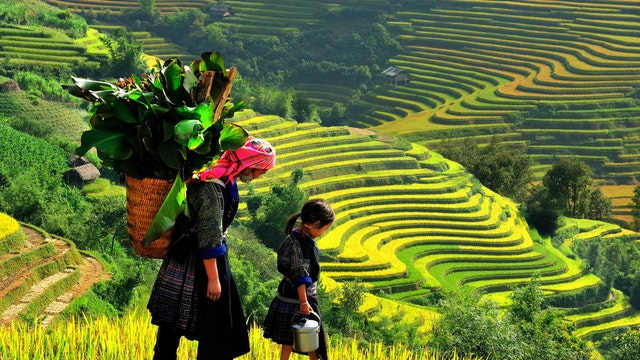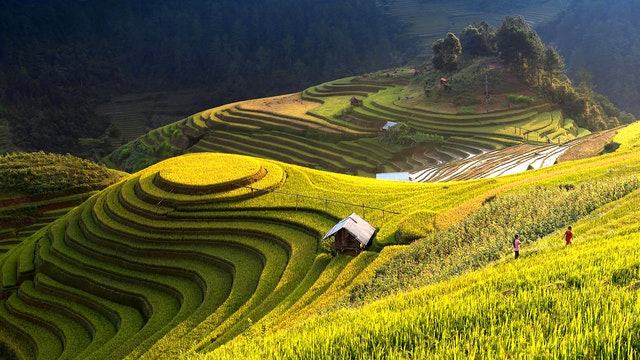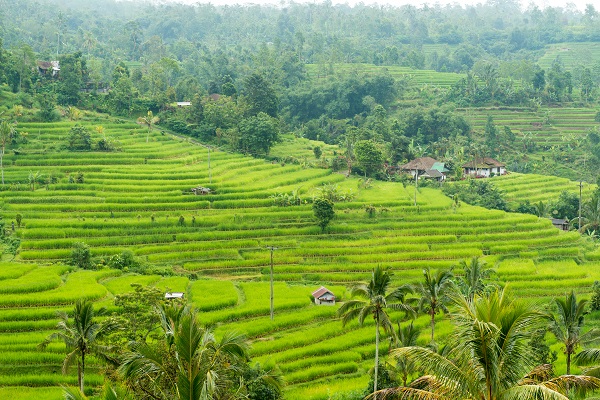Naturally crops like to grow in plain land or flat place. But in the hilly area, this isn’t possible to grow crops in natural ways. To supply food for family and community, the farmers of that area came up to solved this problem thousands of years ago. The solution to that problem was a great process to cultivate more and more crops. This traditional process named ‘terrace farming’ and also practices at present time in the hilly area.
In this context, we discuss this farming and the process of this cultivation. Before unfold of this cultivation method we need to no terrace farming meaning properly. In a scientific manner, this cultivation helps to reduce erosion of the soil. Terrace farming meaning is the cultivation process of step by step onto the mountains or hills.
#What Is Terrace Farming?

Here we try to define the terrace farming method or clear your query on what is terrace farming? The answer is, the terrace cultivation is a manmade terrace that developed into slopes. This farming was first invented in the South American mountains. It is the method of step by step cultivation onto the hills or mountains. It is an amazing method as at the rain time rain carrying the nutrients of soil and plants below the slope and keeping some areas wet and some dry. Paddy sowing is perfect for this method.
#The concept of terrace farming model:
An idea can give as a model of terrace farming. This farming is commonly seen in different hilly regions of Asia. Paddy cultivation is better in sand mix hilly areas. This farming is done by forming a flat area through the steps on the hill. Under the influence of gravity, water flowing from above flows down. This water used for irrigation. Since paddy cultivation is not good at higher altitudes, in the model of terrace farming, paddy is usually cultivated at the bottom. Other crops or vegetables are grown on the tops of the hills depending on the weather. The terrace farming diagram is shown to make the farmers aware of this farming in the meetings of various advanced agricultural fields where they can be given a good idea about terrace cultivation in a small space.
In the terrace farming model, depending on the weather, different vegetables such as potato, onion, cauliflower are cultivated, sometimes beet, wheat, tea are cultivated and finally, the lands are used for cultivating sand. Then, under the influence of gravity, the water of the spring flowing from the top to the bottom of the hill is used for irrigation of the required land through a drain. Excess water is required. Mixed with the river flowing below.
#How terrace farming actually works:

How Does Terrace Farming Work? If you want to understand the word terrace farming, you have to understand the meaning of the word terrace which means step. In other words, farming with such steps is called terrace farming. Such cultivation is usually seen in hilly areas. Utilizing the effects of gravity, shower water or water flowing from above during heavy rains, when the soil flows from the upper step downwards, the soil flowing from the upper step and the nutrients flowing with it accumulate in the lower step. In this way the material of the upper step and the soil gradually move to the lower step so that the nutrients of the mat are not wasted by flowing through the water. As a result, it is better to cultivate paddy from top to bottom.
#How to do terrace farming at home:

Many people plant various flowering plants on the roof of their house to protect the ecosystem or the amount of oxygen. If some vegetables can be cultivated then fresh chemical free food can be taken in the daily diet. Many people have an idea of house terrace farming, but there is disagreement on how to start. Let’s find out how to do house terrace farming.
- Like other flowering plants, you need to choose a place on the roof where you can get good sunlight and air.
- Small, large and medium sized tubs should be arranged where home grown vegetables can be planted.
- The tubs should be arranged parallel to the roof. The tubs should be filled by preparing the soil by mixing dung manure in a natural way.
- Seeds of various vegetables sold in the market such as eggplant, tomato, gourd, spinach, onion etc. should be brought and planted in the soil.
- Always give water in the tub. However, it should be noted that excess water can destroy the seeds.
- When the seedlings emerge after two to three weeks, care of the seedlings should be started. In order for the tree to grow, mustard shell has to be watered. In addition, household waste should be decomposed into compost and mixed with soil.
- Trees planted at home with regular care will start to bear fruit.
#Types Of Terracing:
There are usually two types of terracing such as bench terrace and ridge terrace. Where bench terrace is cultivated on steep slopes. The soil can be protected from erosion. Ridge this farming is comparatively sloping step farming. This is done by conserving the water flowing from above.
Ridge terrace farming can be further divided into narrow-based and broad-based. Narrow-based terraces are cultivated in narrow alley-like steps. Various spice plants, medicinal plants, flowering plants etc. are cultivated in this manner. On the other hand, in the case of broad-based terrace, cultivation is done by cutting the steps at a distance of 20 to 30 cm. Tea, grapes, apples, aromatic plants are cultivated in this way.
Graded terrace and level terrace are also cultivated in different parts of Asia.
Examples of Terrace Farming Around the World:

Terrace Farming has received new responses from all over the world. The method of producing crops by conserving nature using natural energy is very ancient.
Asia is first for that farming. Most of the paddy cultivation in Southeast Asia is done in this manner. terrace farming is seen in various countries including Vietnam, India, Thailand for having a suitable seasonal climate.
Along with this farming can be seen in the countries of the Mediterranean region. Terrace cultivation is located north of Lake Geneva in the Lavax region of Switzerland. Which reveals the tradition of the twenty-first century.
The contribution of South America to that farming is undeniable. The first method of ancient terrace cultivation was found in South America. At present, the importance of this Farming is being given more importance in many modern farms. A 2013 study found that a 2,000-year-old terrace farm was used near the desert town of Petra.
Advantages of terrace farming:
When it comes to the advantages of terrace farming, the protection of natural resources should be mentioned first. Because it is an agricultural work method where the resources are protected by managing the nature instead of harming it. The advantages of terrace farming are discussed below-
- Since this cultivation is done in steep hilly areas, soil erosion and landslides are less.
- Soil nutrients in the upper layer gradually flow to the lower layer. As a result the fertility of the soil is maintained.
- The new sediment that flows into the upper water during the rainy season makes the bottom step more fertile. As a result, the cultivation of donations at lower levels is better.
- Natural springs are used to irrigate the land. As a result, it costs more to irrigate and less physical labor.
- The roots of the crop hold the soil of the hill in order to grow the crop on the hill steps. This protects against heavy erosion in heavy rains.
Disadvantages Of Terrace Farming:
When nature is used, there are advantages and disadvantages in cultivation. The disadvantages of this farming are discussed below.
- Heavy rains can cause extensive damage to this farming. Excessive rainfall lowers landslides resulting in spoil to the steps.
- Essential soil components are washed away with water for excess water flow. As a result, there is a lack of nutrients required for crop production.
- A lot of manual labor is required for cutting down hills, constructing steps, digging ditches for irrigation.
- Terrace shots require a lot of labor to maintain.
- If you want to cultivate in a modern way, even if the labor is less, the financial cost becomes more.
- After a certain period of time the soil becomes unsuitable for cultivation.
#Ideas about terrace farming in India:

India is a major agricultural country. It is possible to grow crops in the hilly areas as well as in the plains. In terrace farming in India, different states have increased the value of the economy in the court of the world by giving good yields. If you search on the internet about in which state terrace farming is practiced, you will first see states like Punjab, Meghalaya in India. Apart from this, terrace cultivation can be seen in the plains of Uttar Pradesh, Himachal Pradesh and the northern region.
In India, terrace farming is usually done in two ways which is known as bench terrace cultivation and ridge terrace cultivation.
Bench terrace farming:-
In this farming relatively steep hilly land is used. Bench terrace cultivation is done by cutting the slope in the hilly land and leveling it like a bean. Bench terrace farming can be divided into different parts based on environment and soil. Such as for flower gardening, comparatively infertile soil etc. where it is possible to produce a variety of crops.
Ridge terrace farming:-
In this farming, the slopes are relatively sloping. Appropriate water removal arrangements have to be made here. So, according to the need of the soil, the water flowing from above has to enter the land through small drains for irrigation.
In terrace cultivation in India, different crops are produced at different levels. Crops like paddy, cereals, fruits, vegetables, flowers, fragrant plants, rye, wheat, maize, rice, pulses, oilseeds, buckwheat, beetroot, saffron, black cumin; grain invocation spices etc. are produced through terrace farming.
Conclusion:
Therefore, various modern methods are used to improve agriculture. But the chemical fertilizers used in this modern method reduce the quality of food. At the same time, through water irrigation, that material flows elsewhere and causes water pollution. In the old method of terrace cultivation, the quality of food is maintained properly while maintaining the natural balance. Here is a brief overview of terrace farming discussed above from which you may be interested to start terrace farming.
